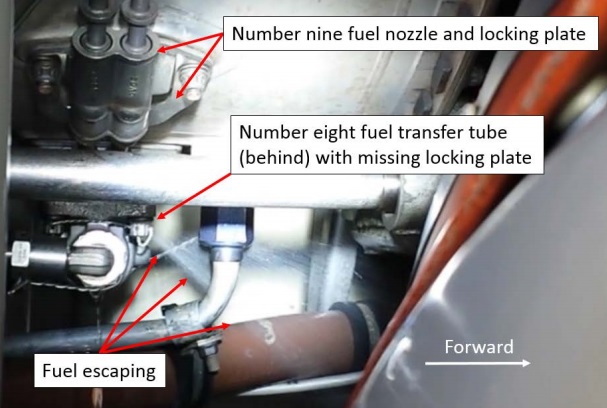Cessna 208 Forced Landing: Engine Failure Due To Re-Assembly Error
On 11 November 2016, Cessna 208B Caravan VH-TYV (‘TYV’) of Hardy Aviation departed from Darwin Airport, NT. On board were an instructor and trainee pilot who were to conduct an aircraft type re-familiarisation training flight.
The Engine Failure and Force Landing
In their investigation report the Australian Transport Safety Bureau (ATSB) say:
After take-off at an altitude of about 500 ft above ground level (AGL), the instructor noted the climb speed reducing while the trainee continued to maintain the nose attitude for best angle of climb. At the same time, the instructor heard the engine lose power and a thin film of fuel partially obscured the windscreen.
As the airspeed reduced to 60 kt, the instructor took control of TYV. They identified an area to the left of the aircraft as the most suitable for a forced landing and began a left turn towards that clear area at the target glide speed of 85 kt. As the aircraft turned, they assessed that sufficient height remained to continue the turn back towards Darwin Airport. At the completion of the turn, they selected 30 degrees of flaps to provide a short climb, which allowed the aircraft to clear two hangars and an area of trees.
After clearing the hangars and trees, the instructor observed taxiway A in line with the aircraft and elected to land on the taxiway. The aircraft landed without further incident.
Engineering Investigation & Analysis
The ATSB report that:
A post-incident examination of the engine found the number eight fuel nozzle locking plate missing.
There was no damage to the locking plate mounts.
The fuel nozzles had been replaced 86 flight hours prior to the incident, while the aircraft underwent maintenance in the United States, prior to importation into Australia.
The ATSB determined that:
The locking plate was probably not reinstalled when the fuel transfer tubes and nozzles were installed after replacement.
The missing locking plate allowed the fuel transfer tube to slowly migrate out of the nozzle adaptor over the subsequent 86 flight hours. On the incident flight, the fuel transfer tube migrated far enough that fuel under pressure was able to escape from the nozzle adaptor.
We have written about Critical Maintenance Tasks previously in an enduring popular article. Also see our articles:
- Fatal $16 Million Maintenance Errors
- Loose B-Nut: Accident During Helicopter Maintenance Check Flight
- USAF RC-135V Rivet Joint Oxygen Fire
- The Missing Igniters: Fatigue & Management of Change Shortcomings
- Misassembled Anti-Torque Pedals Cause EC135 Accident
- EC130B4 Accident: Incorrect TRDS Bearing Installation
- Misrigged Flying Controls: Fatal Maintenance Check Flight Accident
- UPDATE 16 April 2017: Insecure Pitch Link Fatal R44 Accident
- UPDATE 22 July 2020: NDI Process Failures Preceded B777 PW4077 Engine FBO
ATSB Safety Message – Airworthiness
This incident serves to underline the importance of ensuring all maintenance is completed entirely and correctly.
[It also] demonstrates how the effects of incomplete maintenance can take a long period of time to manifest.
The ATSB research report: An overview of human factors in aviation maintenance provides information on human factors errors made in the maintenance environment.
Also see our articles:
- Professor James Reason’s 12 Principles of Error Management
- How To Develop Your Organisation’s Safety Culture
- Aircraft Maintenance: Going for Gold?
- Airworthiness Matters: Next Generation Maintenance Human Factors
ATSB Safety Message – Flight Operations
This incident also provides an excellent example of the value of regular training and the effective implementation of procedures following engine failure after take-off in a single engine aircraft.
Successful completion of a turn back manoeuvre to land on the departure runway, or other suitable airport area, requires well-developed procedures and good pilot proficiency to ensure procedures are effectively applied. Careful consideration of the characteristics and performance of each aircraft type is required when developing turn back procedures. The impact of wind and weather conditions must also accounted for when electing to conduct the turn back procedure.
As demonstrated in this incident, during the turn back the pilot should constantly assess the ability of the aircraft to complete the procedure and be prepared at any time to cease the turn and land ahead.
The ATSB research report: Avoidable Accidents No. 3 – Managing partial power loss after take-off in single-engine aircraft provides information to assist pilots handling both partial and complete engine power loss after take-off.
Pilots can significantly reduce risk following a partial or complete engine power loss using the following strategies:
• pre-flight decision making and planning for emergencies and abnormal situations for the particular aerodrome
• taking positive action and maintaining aircraft control either when turning back to the aerodrome or conducting a forced landing.
Other C208 Accidents
We have previously written these articles on C208 accidents and incidents:
- Micro FOD: Cessna 208B Grand Caravan Engine Failure & Forced Landing
- NTSB Report on C208B Caravan Ditching, Molokai, Hawaii, 2013
- Canadian Mining Icing Air Accident (Cessna 208B Caravan)
- Flying Control FOD: Screwdriver Found in C208 Controls
- UPDATE 29 November 2018: Iced C208 Loses Airspeed During Circling Approach and Strikes Ground
Aerossurance is pleased to sponsor the 2017 European Society of Air Safety Investigators (ESASI) 8th Regional Seminar in Ljubljana, Slovenia on 19 and 20 April 2017. Registration is just €100 per delegate. To register for the seminar please follow this link. ESASI is the European chapter of the International Society of Air Safety Investigators (ISASI).
Aerossurance sponsored an RAeS HFG:E conference at Cranfield University on 9 May 2017, on the topic of Staying Alert: Managing Fatigue in Maintenance.
Aerossurance is pleased to be both sponsoring and presenting at a Royal Aeronautical Society (RAeS) Human Factors Group: Engineering seminar Maintenance Error: Are we learning? to be held on 9 May 2019 at Cranfield University.





Recent Comments